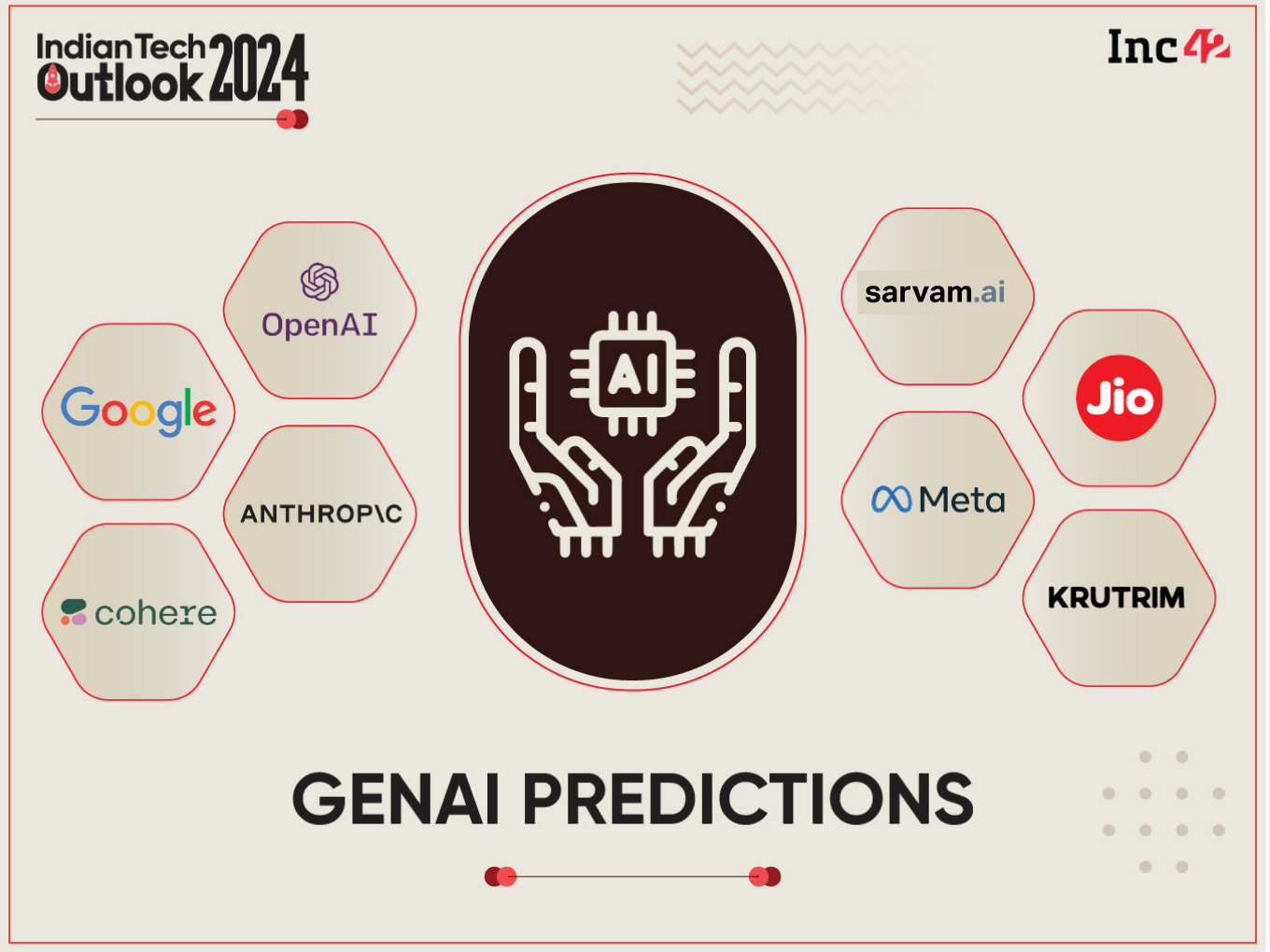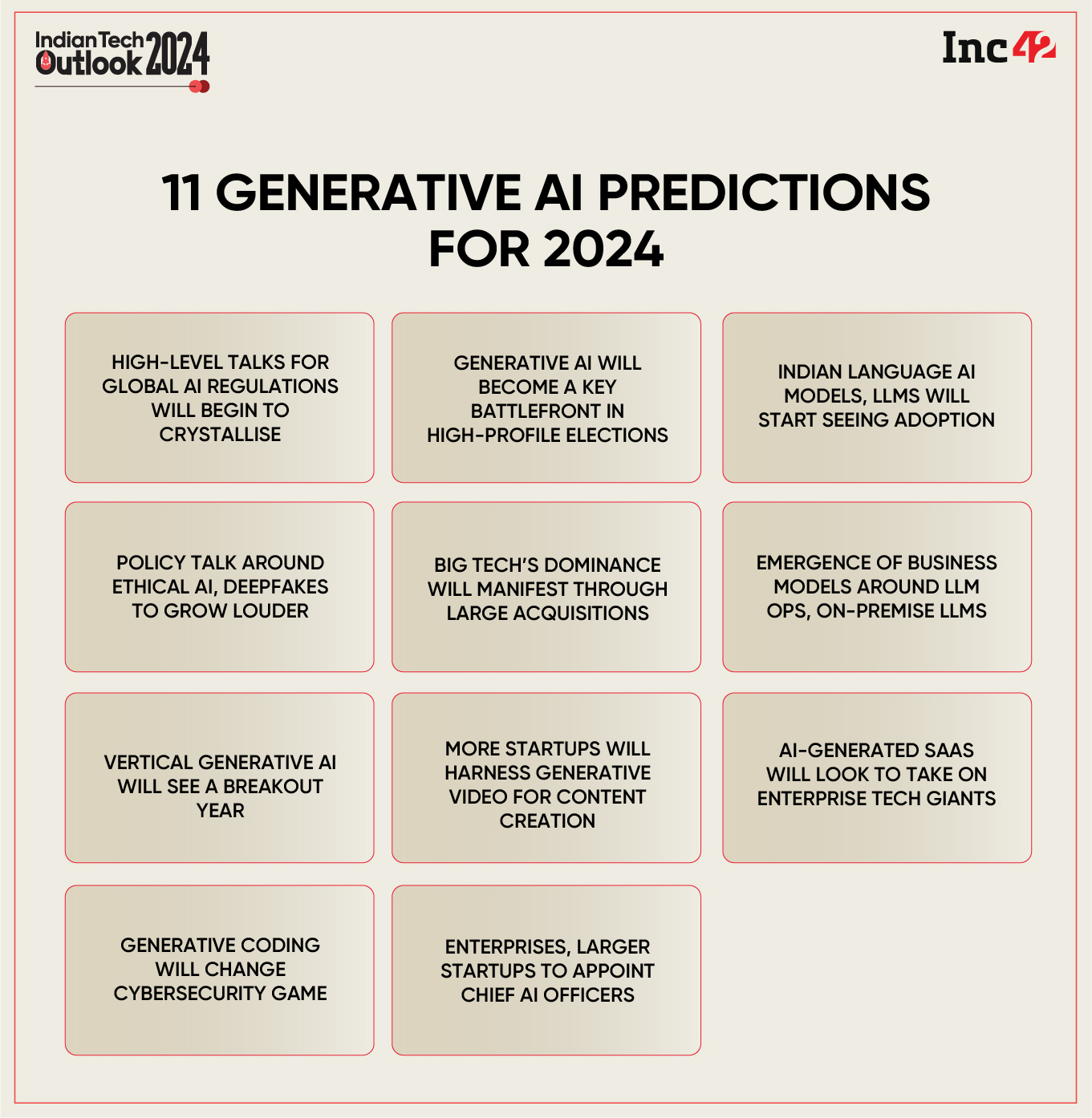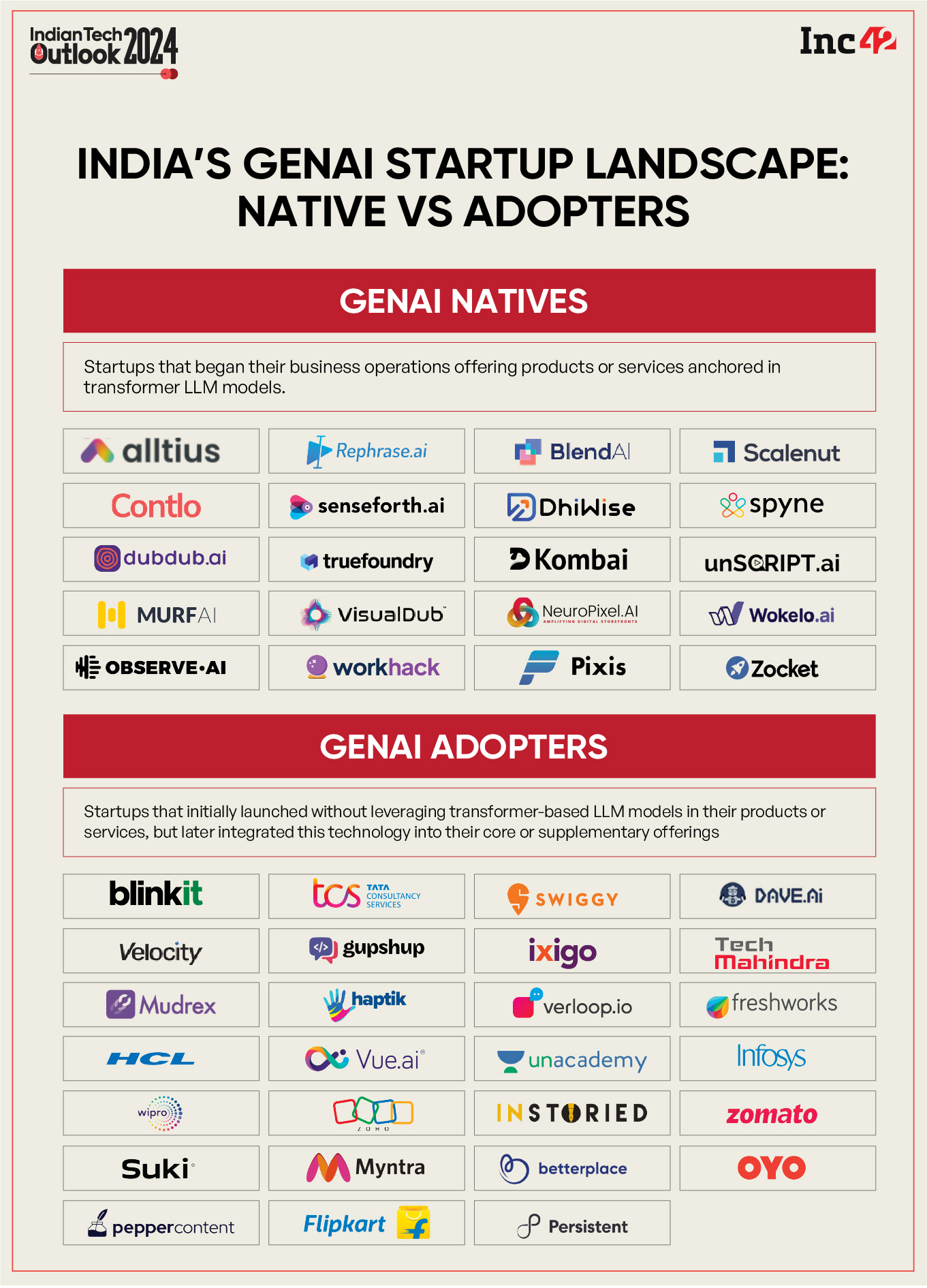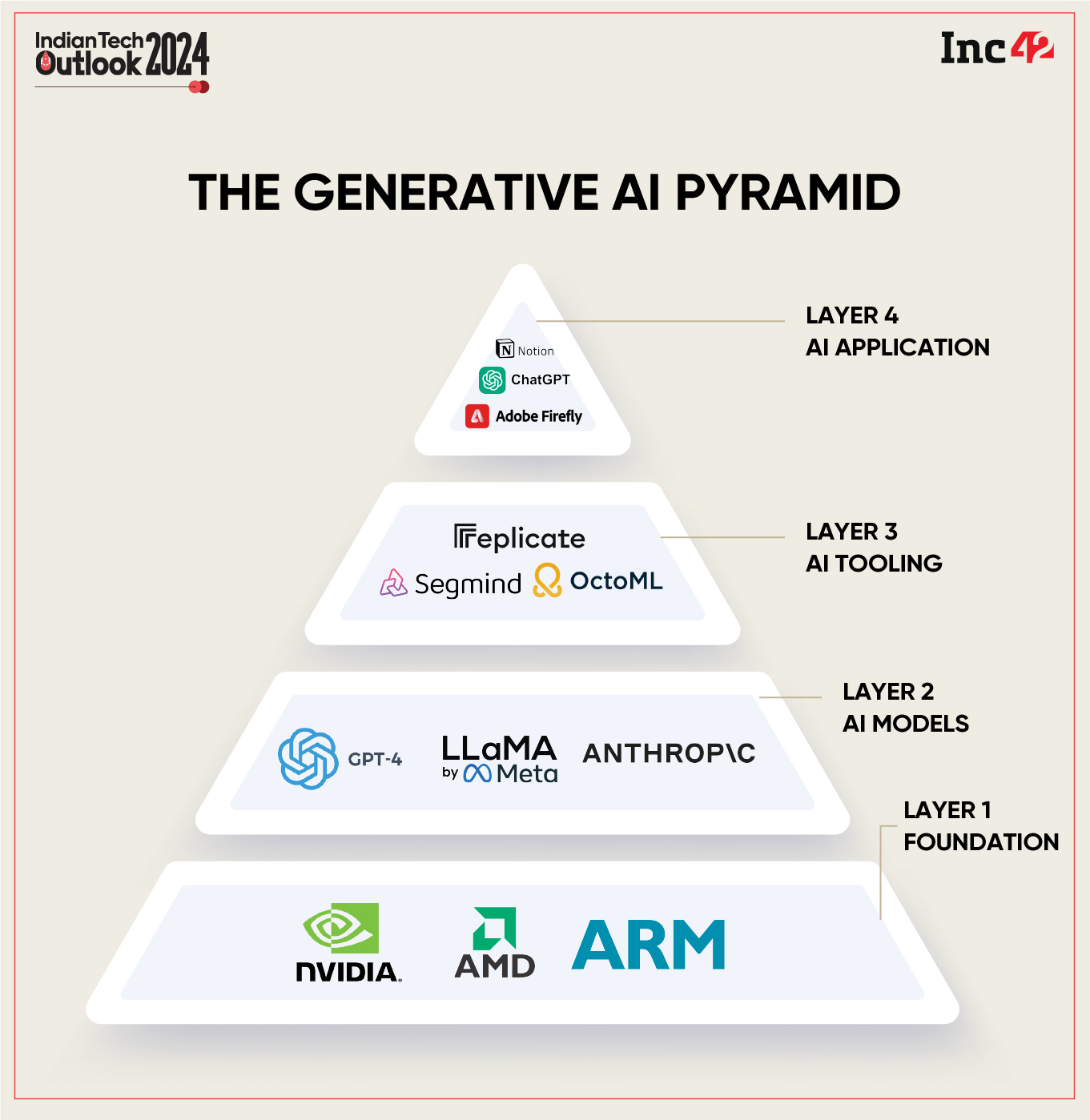10 Generative AI Predictions For 2024

The end of 2023 was something of an anti-climax for AI. Especially, after a year, where you could pretty much not avoid generative AI, OpenAI, ChatGPT and everything else that came with being in the so-called next generation of technology. And of course, Indian startups jumped on to the generative AI bandwagon swiftly.
But by the end of 2023, perhaps everyone was just a tad tired of the trite takes or as one investor told us, the end of 2023 was the end of AI as a fad. After 12 months of the ‘best ChatGPT prompts’ and ‘look what Midjourney is capable of’, perhaps 2024 is the year that generative AI grows up.
That is an odd thing to say for something so new, but like any other technology that came before it, generative AI needs to mature and 2024 is expected to be the real coming of age, which will be led by enterprises, before this maturity seeps into the Indian startup ecosystem.
Of course, we also had IT services giants in India announcing plans to invest in GenAI. Infosys tied up with Google Cloud to develop enterprise AI solutions, and the debate about machines and software taking human jobs turned all too real. But this is just the beginning of the GenAI era.
10 Generative AI Predictions For Indian Startups In 2024
“One of the things I say is that no technology is real and future-proof till enterprise adoption kicks in, and when it comes to GenAI, this is yet to happen. So watch out for this in 2024,” according to Naganand Doraswamy, founder of Ideaspring Capital adding, that enterprise adoption is bound to happen as data silos break down.
In other words, enterprise adoption is not really a trend; it’s just a matter of time before it happens. And it’s only after this that Indian startups will look at generative AI seriously, since enterprise revenue often dictates new-age models.
At the moment, the enterprise consideration is on the buy-vs-build lines, where enterprise data is still largely in silos despite the data revolution that preceded the GenAI moment.
Aside from this, what can we expect from the world of generative AI in 2024? Here are 10 predictions (ironic, we know) of the trends that will shape GenAI in India in the year ahead.

High-Level Talks For Global AI Regulations Will Begin To Crystallise
Ever since we first heard about AI, there have been concerns raised about the rise of machines, the impact on human jobs and of course the danger of decision-making becoming less humane and more mechanical.
And with generative AI rising, these concerns have grown louder. Zoho cofounder and CEO Sridhar Vembu took up the mantle in 2023, in a public letter co-signed by Rajiv Kumar (former NITI Aayog vice-chairman) and Sharad Sharma (cofounder tof iSPIRT Foundation).
Noting that AI could put millions of jobs at risk overnight, the open letter said that adopting new technologies such as AI, without appropriate safeguards could cause ‘unprecedented disruption of the existing social order’.
AI has significantly impacted the employment sector in India, since it has helped automate several tasks, leading to job displacement, said Jaideep Kewalramani, COO at TeamLease, Edtech. He added that it is also creating new opportunities in AI-related fields which can be an advantage for India’s base of engineers.
The signs of human roles being replaced by generative AI are evident in the Indian startup ecosystem. And there is some backlash already. The founder of a Bengaluru-based ecommerce tech company learnt this when he claimed to have let go of his customer support team after using ChatGPT tools.
Larger companies like Paytm are also choosing to use AI applications to replace human roles, when the fintech giant laid off 1,000 employees in December 2023.
But when it comes to actual legislation, there is a lot of ground to cover to prevent large-scale impact on startup jobs and other tech roles. The Indian government has said that since AI is a global development, laws and regulations need to be more inclusive in nature.
This is where the Global Partnership on Artificial Intelligence (GPAI) could play a role in 2024. A forum of 28 nations and the European Union (EU), the GPAI is looking to understand the challenges and opportunities in AI, and promote responsible evolution.
As chair of GPAI, India hosted the annual summit in December and at the time, Prime Minister Narendra Modi said that India will launch an AI mission so that small companies and startups get the required help and access to resources.
In late 2023, the EU rolled out the world’s first legislation aimed at regulating the use of AI. In 2024, many nations would be eyeing the EU model to create nation-specific AI laws, similar to how GDPR was used as a model for personal data laws.
The Indian government is yet to announce any timelines for a national AI law, we expect more urgency on this front in 2024. One can also foresee more high-level talks around global AI regulations as GenAI becomes more mainstream and as adoption grows across large and smaller companies.
Generative AI Will Become A Key Battlefront In High-Profile Elections
With key elections around the corner in the US and India, it’s no surprise that lawmakers are keen on formulating AI rules as soon as possible. Misinformation is a major challenge in the run up to such major elections as we have seen in the past.
If the 2015 US Presidential elections already turned the spotlight on misinformation (remember Cambridge Analytica?), then generative AI is a whole new ballgame.
India is slated to have the General Elections in mid-2024 and the US will also enter the Presidential election phase in the year. And while the use of technology has grown unabated in electoral campaigns, generative AI poses an altogether new threat where no one can be sure about what is real and what is AI-generated.
Already, there has been some talk in India about social media platforms needing to clean up their act when it comes to GenAI content, and we expect more pressure on intermediaries in the coming days as the election races heat up.
In December 2023, the Ministry of Electronics and Information Technology (MeitY) rolled out a new advisory to all social media platforms to comply with existing IT rules and ensure that deepfakes (AI-generated videos) and any related misinformation are curbed. The IT ministry has directed intermediaries to ‘clearly and precisely’ inform users about what kind of content is prohibited.
We do not know what twists and turns AI will bring to the race for power, but we can say with some certainty that 2024 will see AI create a new paradigm for how elections are fought and won.
Startups Will Bet Big On Ethical AI Models
While elections and law enforcement are the primary focal point for the government and legislators, there is also a parallel effort by tech startups to create what is being called “Ethical AI” or eAI.
It’s built around well-intentioned and well-defined ethical guidelines regarding what are considered fundamental internet rights — individual rights, privacy, non-discrimination, and non-manipulation.
US AI giant Anthropic is arguably the most high-profile example of a startup that has registered as a ‘Benefit Corporation’, an example followed by Elon Musk when he launched xAI in late 2023.
Being a ‘benefit corp’ essentially means the company will prioritise being a benefit to society over its fiduciary duties to investors. For instance, an incorporation filing for xAI says its general purpose is to “create a material positive impact on society and the environment, taken as a whole”.
Don’t get this wrong: Ethical AI is still big business. Anthropic claims to have an ARR of $850 Mn in 2024, and raised more than $6 Bn in 2023.
But again, there is some debate about how Ethical AI companies are practising self-regulation which means one company’s ‘ethics’ may not exactly align with each other.
And Indian startups are far too early in this space to be looking at uch considerations.
Ideaspring’s Doraswamy believes that unfortunately India still needs enriched data. Despite the internet growth of the past decade, India is still a data-poor nation, which makes it harder to make impactful models. “For AI to truly have an ethical impact, the key is health data, education data and social data. Financial data currently has low AI applicability, but without the key data pillars, AI development in India will remain on the surface.”
Indian Language AI Models, LLMs Will Pick Up Pace, Funding
While global regulations are well and good, the bigger fish for many Indian startups will be the domestic business opportunity. In this regard, ‘AI For India’ has become a buzzword, with mega launches (Bhavish Aggarwal’s Krutrim SI) and big seed rounds (Sarvam AI’s $41 Mn Series A) signalling what’s to come in 2024.
According to Kushal Bhagia, founder of All In Capital, ‘AI For India’ may manifest as an extension of the existing digital public infrastructure (DPI) push from the government. This is also likely to prioritise the development of large language models (LLMs) that are built around Indian languages and dialects.

Indian language models will be a critical pillar of AI for India as non-English internet users outnumber English language users in the country. Google rolled out support for nine Indian languages for its GenAI chatbot Bard, soon after OpenAI did the same for its ChatGPT app. India is a big focus area for these AI giants, and naturally startups are eyeing their own piece in this melee.
“The India Stack’s natural progression would be when processes like eKYCs, signing up for schemes, applying to entrance exams, applying for permits/licences could be simplified by LLMs and generative AI. This could be enabled by public-private partnerships where fine-tuned models by private organisations can get data access for specific functions,” Bhagia added.
There’s also the belief that while closed source models such as Sarvam AI may expedite model development for local purposes and regional dialects, a bigger impetus is likely to come from global open source models which can be customised for India-specific use cases.
“Think of it like Android vs iOS. Open-source AI models are growing in popularity as startups race to compete with highly capitalised companies such as OpenAI or Cohere or Anthropic,” said another Bengaluru-based early stage investor, adding that Indian companies which do not have access to large swathes of capital will likely rely on open source models.
Bhagia added that Indian developers will be a major contributor to low-cost open source models, which are a dark horse amid large models and could be tapped by generative AI startups in India. “Apart from that model-level innovations in India will largely be toward regional language and dialects as current global models require a lot of [training] tokens for those when compared to English.”
Given its recent influence on Indian tech and startups, everyone is keen to find out more about what Reliance is planning on this front as well. Recently, Reliance Jio chairman Akash Ambani said that large language models (LLMs) and generative AI have ‘barely scratched’ the surface of the emerging space.
Jio is in early talks with IIT-Bombay for a BharatGPT programme, and the company has plans to launch horizontal AI products across media, commerce, communication and devices verticals, but there are specific products being planned for each vertical as well.
Big Tech’s Dominance Will Manifest Through Acquisitions
Why is GenAI so big right now? The simple answer is big tech. And yes, OpenAI is big tech in 2024. But like we saw in the cloud computing boom, US-based tech giants have taken the lead in GenAI as well, which leaves them best placed to dictate the future of the market.
According to Prayank Swaroop, partner at venture capital giant Accel, the big companies in GenAI will keep getting bigger because that’s the reality of the sector. If Google’s Gemini AI model outperforms OpenAI in some tests and parameters, there’s no way OpenAI will let its lead slip. So the arms race is well and truly on.
He added that unfortunately, India will not see this kind of a war, unless companies are actively fighting to acquire companies. There are haves and have-nots and he thinks India has more have-nots right now.
“Everybody’s already using these models or they will use Llama if Facebook is generous enough and sticks to the open source model. But Meta has to really, really support Llama in the long run. But even then that would be a US-imported technology, and the gap is already widening,” Accel’s Swaroop added.
Unfortunately for India, the US GenAI giants have the lead on the bottom two fundamental layers of GenAI, which is the hardware foundation and the LLMs. However, Indian companies that are building the AI tooling fabric stand the chance to attract funding and acquisition bids from big tech giants.
On the brighter side, the application layer of GenAI is also an area where Indian startups that are building unique products have the best chance of competing with international companies. Areas such as generative audio or video have immense potential given that each market has specific needs and Indian startups can out compete international companies in these niches.

Emergence Of Business Models Around LLM Ops, On-Premise LLMs
Speaking of new models and outcompeting international companies, one area that Indian startups are currently exploring is LLM Ops and enterprise deployment of offline LLMs or on-premise LLMs for organisation-specific needs.
But having to work with US-based companies means there is a higher incidence of Indian GenAI startups being registered in the US. In that sense, GenAI startups are following the SaaS route to a certain extent.
One example is Giga ML, founded by Varun Vummadi and Esha Manideep Dinne, which has raised funding from Y Combinator and Peak XV. The platform lets companies deploy LLMs on-premise — essentially cut off from the wider world — which it claims helps cut costs and preserve privacy of enterprise data.
Registered in the US, It’s built on top of Meta’s open source Llama LLM and its primary goal isn’t speed but data sanctity and user safety.
Similarly, there’s Portkey.AI, a startup that has built tools to allow businesses to monitor their LLM Ops, connect to multiple LLMs to experiment, improve and manage prompts effectively. It works with OpenAI, Anthropic, Langchain, LlamaIndex, among other LLMs, and boasts of customers such as Postman, Jio Haptik and Springworks.
Founded in January 2023 by Rohit Agarwal and Ayush Garg, the startup raised $3 Mn in its seed round led by Lightspeed Venture Partners and it’s also registered in the US.
Such models are emerging and while Indian entrepreneurs have found niches, one area that still needs to be addressed is that Indian entrepreneurs are increasingly moving to the US to set up their startups.
The situation is complicated for early-stage investors in AI, especially those that have small ticket sizes. While the capital requirements for the infra and application layer are lower, it is not easy to build in a lean manner in AI.
As a result, smaller seed funds have to either settle for smaller stakes while coinvesting with larger funds or basically take unnaturally big bets on a company that may not fit in their thesis, according to Doraswamy of Ideaspring, who largely invests in enterprise tech startups.
Vertical Generative AI Will See A Breakout Year
Will vertical generative AI be the answer to solving India-specific problems from India? Some investors expect wider enterprise adoption to create a new generation of entrepreneurs that can address vertical problems in India, rather than the global horizontal approach.
“Open source models of Mistral are already outperforming GPT3.5 in a few metrics, however, while they manage general tasks well, they are inaccurate for specific tasks. Here, Indian developers and startups will build lower cost fine-tuned models on top of global large models for vertically specific niche use cases. This will enable AI for India with our own data, leveraging global resources,” added All In Capital’s Bhagia.
Accel’s Swaroop is similarly hopeful of Indian startups on the application and the infrastructure or fabric layer of generative AI. But here they are hamstrung by the lack of customer data of the kind that Freshworks or someone else has which is a big moat for larger companies.
Even companies such as Sarvam AI, which has raised $41 Mn already, will need hundreds of millions of dollars to be able to build something and then the question remains how robust their model is in comparison to the US giants. Indian developers are not loyal to India and there is a brain drain problem in GenAI as well.
Bhagia added that as pure-play models are generally expensive, the early-stage firm anticipates more activity on the infra or tooling layer. He pointed to All In’s portfolio startups such as Segmind (model optimisation) or Supernova (AI tutor for kids), which received day zero investments from the firm.
“Indian startups have locally built and scaled SaaS for global markets. Similar patterns may play out in Generative AI’s application layer too. There will be 3Cs for GenAI apps by India for the world – Creative tools, Companionship and Copilots,” the All In Capital founder added.
Marketing Tech Will Ride GenAI Surge
While most startups are leveraging generative text and images to solve operational overheads, one area that is likely to see a major boost in 2024 is generative video thanks to adoption in marketing and advertising.
Typically, generative video uses a lot of resources and requires millions of dollars to operationalise, unless there is a big commercial drive.
Hippo Video founder Karthi Mariappan told Inc42 earlier that hardware costs alone are very high for most startups because of how many discrete graphics processors are needed to generate AI video. The startup leverages AI models to create videos that help product teams amplify engagement around marketing content and promote AI avatars.
“It’s [generative video] definitely capital intensive as of today. But we see that tapering down as more and more innovations come in. Now Nvidia is releasing data centres specific for Gen AI. So kind of a lot of innovations are happening on the DevOps front that can reduce the costs in the long run,” Mariappan said.
AI-generated content has seen marketing applications on platforms such as MoEngage, Clevertap, Pepper Content and others. This is most likely to trickle into generative video and more martech startups will adopt AI to flesh out their products.
Sources in the industry indicate that martech startups are starting to look at acquisitions of early-stage AI startups to build marketing-specific features rather than implementing horizontal AI. Here too generative video will play a part.
Adoption is key to breaking this vicious loop. Accel’s Swaroop added education and edtech startups will be impacted dramatically as video content generation becomes widespread.
“Then there’s the digital entertainment space. The likes of Pocket FM, Kuku FM, Pratilipi and all could theoretically scale up content production by thousands with AI-generated audio. And they can add another layer of engagement if generative video also grows to a point where their stories can be automatically made into short videos,” the Accel partner added.
AI-Generated Software Will Disrupt Everything
Software will eat the world, but there’s also the fear that ‘Software 2.0’ will eat software itself. One of the early use cases for generative text has been in machine-coded software. We have seen examples of users recreating popular apps with generative code.
No-code startups have sprouted around the world in this GenAI age. If Google and Microsoft are offering no-code ML tools, businesses such as Akkio, Levity, Gyana, and Indian startup Builder.AI are building dev tools around this to ease deployment of software and creating custom versions of software.
But if legitimate software development has been eased by GenAI tools, the same could be said for malware and rootkits, which are just malicious forms of software. The rise of AI-powered hacks will also see cybersecurity teams deploy self-healing software, which develops itself on the fly to thwart potential attackers.
In this regard, on-premise LLMs might be the preferred route for enterprises as they look to ward off attacks such as prompt injection. Prompt injection attacks aim to elicit unintended responses from LLM-based tools. Early versions of ChatGPT and others were vulnerable to certain prompts being entered by the user themselves, but open source models are even more susceptible to manipulation of prompts by a middle-man or being fed malicious content to exploit the system.
Accel’s Swaroop added that it could be as simple as changing the tone of responses given by a chatbot such as ChatGPT or Bard, to more malicious forms of attacks such as revealing sensitive customer data (particularly scary for healthcare and financial systems).
On the positive side, AI-generated software has the potential to challenge established players such as Freshworks, Salesforce or other SaaS giants where the data is more openly available. Investors believe that certain products with these SaaS suites might be more vulnerable to competition thanks to the rise of AI software in 2024.
Enterprises, Indian Startups To Hire For Generative AI
We started this outlook story with a bit about enterprises, and how adoption by this class of businesses will be key for Gen AI. Enterprise-focussed use cases are still in the nascent stage, and enterprises themselves are still figuring out how to best utilise LLMs and other GenAI tools.
One area where we expect to see a lot more activity is hiring of AI talent and particularly in leadership roles. Enterprise hiring will be the big signal here. “We are already seeing leadership hiring and positions like chief AI officer (CAIO). Budget allocation for people is going to rise in 2024, but companies will be hiring for AI-specific roles, because they realise that it’s not possible to run this as a side project. AI needs focussed effort,” added Doraswamy.
A chief AI officer would not only be responsible for setting a company’s overall AI strategy, including the design, development, and implementation, but would also have to work closely with policy heads in government departments to ensure compatibility with future legislation on AI. It is a much broader role than just someone who knows the ins-and-outs of AI and the engineering side of things.
Even though Infosys and other IT giants in India have major plans in the GenAI world, the trend of the CAIO has not yet crossed over to India. It is very likely 2024 will see the first major appointment in this regard, breaking the dam. But even on the engineering side, a lot of competition is expected for the right AI talent.
The post 10 Generative AI Predictions For 2024 appeared first on Inc42 Media.
No comments